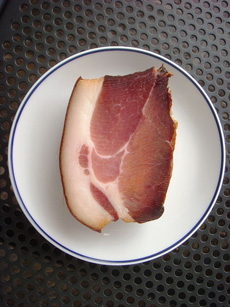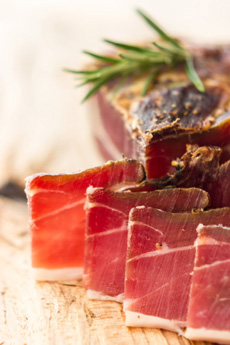TIP OF THE DAY: Try A Speck Of Speck Alto Aldige
|
We’ll admit that we never heard of Italian foods like speck and lardo until about 12 years ago. We were introduced at Mario Batali’s restaurant Otto, in Greenwich Village (that’s otto, pronounced owe-toe, the number eight in Italian, the resto’s street address). Lunching with our fellow editor—two worldly eaters—we asked each other, “What is speck?” (The tantalizing answer is in the next section.)
Speck has been mass produced for some time, but if you seek out the name-protected Speck Alto Aldige, you can take a bite of a ham that dates back to 1200 C.E. (although the modern word “speck” first appeared in the 18th century*), and is still made with time-honored techniques. The Italian region known as Alto Adige (also called Südtirol, South Tirol) is where Italy, Austria and Switzerland meet. A beautiful place to visit—picturesque villages, verdant fields and stunning views of the Dolomite mountains—it is home to one of the world’s finest smoked, cured hams, Speck Alto Adige, often called a “cousin of prosciutto.” Lightly infused with seasonings and smoke, Speck Alto Adige has a distinctive, natural taste, with balanced flavors and delicate aromas—bits of herbaceousness, smokiness and sweetness. |
Thick slices of speck. Pour a glass of red wine and enjoy! Photo by F.P. Wing | IST. |
|
|
THE DIFFERENCE BETWEEN SPECK & PROSCIUTTO Thinking back to our first experience, we asked around; only our wine editor had the correct answer. Since that day at Otto in 2001, we’d encountered speck on menus, often called “speck prosciutto and “Tirolean prosciutto.” No doubt the proper name, Speck Alto Aldige, would be more confusing. No wonder most people are confused (if not entirely ignorant). Another factor is that we didn’t grow up with authentic speck. It’s only in the last decade or so that it’s been imported into the U.S. True Speck Alto Aldige, IGP (Protected Geographical Indication, bestowed on products that can trace their roots to the 15th century) is a distinctive artisan product, a culinary delight, and something you should get to know. So what’s the difference between speck and prosciutto? *In some English-speaking countries, “speck” refers to Italian Speck, a type of prosciutto, rather than German Speck, which is identical to the Italian lardo. The term “speck” took hold in the 18th century, replacing the older term “bachen,” a cognate of “bacon.” “Speck” is an English word meaning “fat” or “blubber,” which has been in use since the early 17th century. This word is also used in German, but in Germany it typically refers to pork fat with or without some meat in it.(Source: Wikipedia) |
||
 Eat with a knife and fork, or make a very sophisticated ham sandwich with Fontina or Gruyère and dill pickle slices. Photo by Mumantai | Wikimedia. |
WAYS TO ENJOY SPECK Hors d’Oeuvre & Starters |
|
|
Sides
To guarantee the quality and authenticity of Speck Alto Adige, the trade association Consorzio Tutela Speck Alto Adige and the independent control institute INEQ (Istituto Nord Est Qualità) verify compliance with the quality parameters throughout all phases of production. Inspectors may visit the production sites at any time to be sure controls are being met. Only those hams that meet the stringent production criteria are fire-branded with the Speck Alto Adige seal, as proof of their quality and authenticity. If you can’t find Speck Alto Aldige in a local specialty foods store or Italian market, you can buy it online. You can also get to know other types of speck. A cousin of the Italian original, La Quercia in Iowa makes a nice “American” speck, but it’s as distant a relation to Speck Alto Aldige as domestic Parmesan is from Parmigiano Reggiano. You can also find Black Forest Speck from Germany and Gailtaler Speck from Austria. Some Jewish delis sell a beef product called speck that is made from beef. Eliminate any confusion and try to find Speck Alto Aldige. As with anything, go for the best. Bargain brands usually represent bargain flavors; and when people tell us that they don’t like this or that, we suspect it’s because they’ve tried a lesser brand.
|
||



